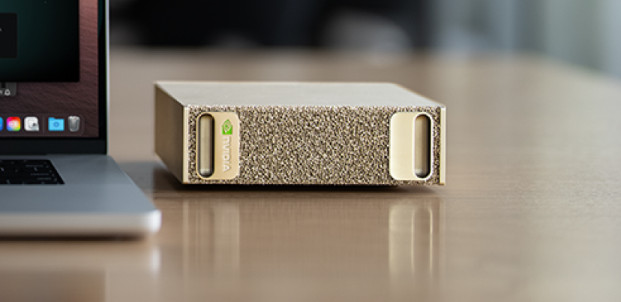The NVIDIA DGX Spark, formerly known as Project Digits, has been dubbed a “Grace Blackwell AI Supercomputer on your desk”. This tiny system is redefining what’s possible in a desktop form factor by bringing data center AI capabilities directly to developers and researchers.
However, its launch has generated significant discussion, particularly around its pricing, performance metrics, and unique architecture.
Key Technical Feats of the DGX Spark
The DGX Spark’s core power lies in the revolutionary NVIDIA GB10 Grace Blackwell Superchip.
| Component | Specification |
|---|---|
| Superchip | NVIDIA GB10 Grace Blackwell Superchip |
| Memory | 128 GB of coherent unified LPDDR5X memory |
| AI Performance | Up to 1 PetaFLOP (1,000 TOPS) at FP4 precision |
| CPU | 20 ARM cores (10 Cortex-X925, 10 Cortex-A725) |
| GPU | Blackwell GPU (often compared to an RTX GeForce RTX 5070 class GPU) |
| Networking | Dual QSFP 56 ConnectX-7 Smart NIC (200 GbE RDMA) plus a 10 GbE port |
| Memory Bandwidth | Approximately 273–279 GB/s |
| Power Consumption | Max rated power consumption around 240 W (via power adapter), but typically idles around 44–45 W |
DGX Spark Pros and Cons
🟢 Pros
- Massive Memory Footprint: The 128 GB of unified memory is the primary selling point. This allows developers to run relatively large models that exceed the capacity of most consumer desktop GPUs.
- Professional Scalability: The integrated ConnectX-7 Smart NIC enables direct attachment of two DGX Sparks using a 200 GB QSFP 56 cable, creating a 256 GB memory domain capable of running models up to 405 billion parameters. This RDMA networking feature provides an easier, high-end path for clustering compared to consumer setups.
- Ecosystem Consistency (AI Lab in a Box): It runs DGX OS, which is built on an Ubuntu base. This provides an identical software stack (CUDA, cuDNN, NCCL, RAPIDS) as large DGX data center systems, ensuring development work scales directly to bigger clusters.
- Portability & Acoustics: It is an absolutely tiny system that can literally fit in a backpack. It is also designed to be super quiet, remaining below 40 dBA even during setup when power consumption peaked around 80 W.
- Low-Precision Optimization: The Blackwell GPU supports NVFP4 (Nvidia’s special 4-bit format), which trades bits for bandwidth, allowing it to fit more data into the LPDDR5X memory and accelerate compute.
🔴 Cons (Driven by Hacker News Critique)
- Bandwidth Bottleneck: The 273–279 GB/s LPDDR5X memory bandwidth is considered a major limitation. This rate is significantly slower than the RTX 5090 ($\sim$1.8 TB/s) or the M3 Ultra Mac Studio (819 GB/s), leading commentators to conclude the Spark “doesn’t have a lot of compute and bandwidth”. This low bandwidth limits the tokens per second during response generation.
- Misleading PetaFLOPs: The claim of 1 PetaFLOPs is labeled as “disingenuous” and “incredibly misleading”. This number is theoretical and relies on FP4 precision and structured sparsity. Without those aggressive optimizations, the actual generalized FP8 performance is estimated closer to 250 TFLOPS, or as low as 125 TFLOPS when factoring in the typical 50% gain from sparsity.
- Poor Value for Compute: When comparing calculated FP4-sparse TFLOPS per dollar, the DGX Spark is estimated at $4.00 per TF4s, which is much worse than the projected NVIDIA 5090 at $0.60 per TF4s.
- Custom OS Lock-in: The use of a custom ARM chip and the Ubuntu-based DGX OS leads to concerns about becoming “stuck compiling everything from scratch,” similar to issues experienced with older Jetson devices whose software support often lagged.
Comparison to Local 4090, 5090, Multiple 3090, and RTX Pro 6000
The DGX Spark is an AI development platform focused on large model capacity, whereas traditional GPUs prioritize raw speed.
| Comparison Point | DGX Spark Positioning |
|---|---|
| RTX 4090 / RTX 5090 | These high-end consumer cards offer far higher peak performance and 4–6 times the memory bandwidth. They excel at running small models quickly. However, the 4090 (24 GB) and 5090 (32 GB) run out of VRAM quickly for large LLMs. The Spark is better if you need to load models larger than 32 GB. |
| Multiple 3090s | DIY multi-3090 systems can achieve high VRAM (e.g., 512 GB). However, the DGX Spark provides a unified memory architecture and professional-grade ConnectX-7 RDMA networking, offering a clearer, higher-performance path for scaling than standard multi-GPU setups. |
| RTX Pro 6000 (Blackwell) | The RTX Pro 6000 ($9k) offers 96 GB of VRAM and significantly more compute. A dual RTX Pro 6000 workstation (total 192 GB VRAM) represents the next tier up, costing at least $20,000 and being “an order of magnitude faster” than the Spark. The DGX Spark is explicitly not a high-end RTX Pro 6000. |
Tokens Per Second (TPS) Performance
The DGX Spark relies on NVFP4 to achieve competitive inference speeds and capacity. Performance tests, typically using optimized backends like TensorRT LLM (TRT LLM) or VLLM, show promising rates for large models.
| Model | Precision/Quantization | Prompt Tokens/s | Response Tokens/s |
|---|---|---|---|
| gpt-oss 20B | NVFP4 | 169.61 | 49.57 |
| gpt-oss 120B | NVFP4 | 48.17 | 14.48 |
| Qwen3 32B | Q4_K_M | 3.34 | 9.32 |
Other reported performance metrics include:
- Llama 3.1 8B parameter model (NVFP4): Approximately 39 tokens per second.
- Llama 3.3 70B parameter model (NVFP4, speculative decode): Expected to run at about 11–12 tokens per second.
- Llama 3.2B parameter model (FP8 benchmarking): Achieves 93 Frames Per Second (FPS). FPS is often used when benchmarking models in computer vision workflows, such as Intelligent Video Analytics.
Actual Use Cases
The DGX Spark is positioned primarily as a developer’s personal AI supercomputer, providing a stable environment for complex AI workflows.
- Large Model Capacity: The system is explicitly designed for running inference on models up to 200 billion parameters with one unit, or 405 billion parameters when two units are clustered.
- Prototyping and Fine-Tuning: It is ideal for fine-tuning mid-sized models up to 70 billion parameters and prototyping complex AI workflows locally.
- Advanced AI Architectures: It is purpose-built for modern workflows like Generative AI (GenAI), Agentic AI, Retrieval Augmented Generation (RAG), and building text-to-knowledge graphs.
- Ecosystem Training: It serves as a true “AI lab in a box”, allowing developers to learn the full NVIDIA software stack (NIM, AI Workbench, NCCL) and seamlessly transfer their work to massive data center infrastructure (like B200 systems).
- Edge AI and HPC: It functions as an edge platform, supporting AI-driven simulations including robotics, digital twins, and bioinformatics tasks like OpenFold protein folding customization. Some expect corporations may buy these for executives or internal teams to accelerate low-code/no-code AI workflow building.




Recent Comments